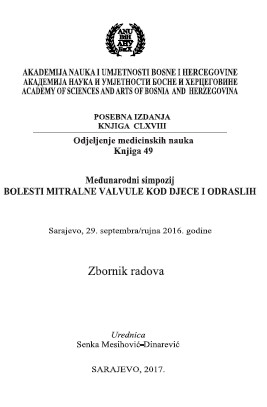ECHOCARDIOGRAPHY OF THE MITRAL VALVE
ECHOCARDIOGRAPHY OF THE MITRAL VALVE
Author(s): Katja Prokšelj
Contributor(s): Adnan Arnautlija (Translator)
Subject(s): Health and medicine and law
Published by: Akademija Nauka i Umjetnosti Bosne i Hercegovine
Keywords: echocardiography; mitral valve; mitral regurgitation; mitral stenosis;
Summary/Abstract: The mitral valve is a complex anatomical and functional structure, composed of the mitral leaflets, mitral annulus, chordae tendineae, papillary muscles and adjacent myocardium. Normal function of all parts of the mitral valve apparatus is essential for normal function of the mitral valve. Different conditions and diseases can cause mitral valve dysfunction, namely mitral regurgitation and mitral stenosis. Echocardiography is a key diagnostic procedure to evaluate the mitral valve. Transthoracic echocardiography is a basic investigation in assessing the mitral valve. When detailed evaluation of the mitral valve is required, transesophageal echocardiography is indicated with the advantage of better resolution and additional views. Two-dimensional echocardiography is useful in the evaluation of mitral valve morphology, heart size and function. Three-dimensional echocardiography is especially useful before surgical procedures, since it gives a better view of the complex mitral valve structure in a “surgeon’s view”. To detect possible mitral valve dysfunction, colour-Doppler echocardiography is used. To properly evaluate the degree of mitral valve regurgitation and stenosis, pulse and continuous-wave Doppler echocardiography is mandatory. Mitral valve evaluation requires a thorough echocardiographic investigation with different echocardiographic modalities and with the use of novel echocardiographic methods, such as three-dimensional echocardiography.
Book: Bolesti mitralne valvule kod djece i odraslih
- Page Range: 26-41
- Page Count: 16
- Publication Year: 2017
- Language: English
- Content File-PDF

